|
 Lactarius clarkeae var. aurantioruber Lactarius clarkeae var. aurantioruber
BiostatusPresent in region - Indigenous. Endemic
Images (click to enlarge)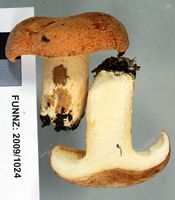
Owner: J.A. Cooper | 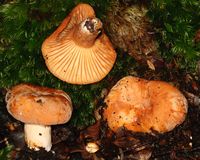
Owner: J.A. Cooper | 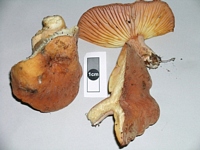
Owner: J.A. Cooper | 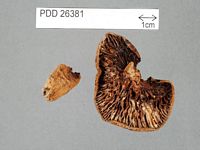
Caption: Dried type specimen
Owner: Herb PDD | 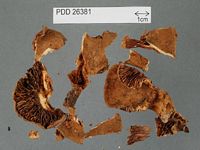
Caption: Dried type specimen
Owner: Herb PDD |
Article: McNabb, R.F.R. (1971). The Russulaceae of New Zealand. 1. Lactarius DC ex S.F. Gray. New Zealand Journal of Botany 9(1): 46-66 (http://www.rsnz.org/publish/abstracts.php).
Description: pileus: 5,5- 10 cm diam., centrally depressed at maturity, dry, often finely rugulose near margins, pruinose-subvelutinate to velutinate-subtomentose under lens, azonate, brownish orange, sordid orange, or orange-red under wet conditions, paler when dry and then greyish-orange or with a white to greyish bloom. Cuticle as in type variety but filamentous elements to 150 µm long. lamellae: adnate to subdecurrent, subdistant, thick, simple or occasionally forked near stipe, to 8 mm deep, creamy white to pallid cream with pink tints, often discoloured with brownish spots where latex has dried; lamellulae present in 2-3 unequal series; latex viscid, white, unchanging on immediate exposure to air, drying brown. stipe: 2-5.5 cm long, ± equal or tapering basally, 1-3 cm diam., solid, dry, finely pruinose-subvelutinate under lens, ± concolorous with pileus or slightly paler, basal mycelium white; flesh pallid orange-yellow, unchanging. Cuticle as in type variety. spores: spore print white; spores as in type variety. hymenium: basidia, pleurocystidia, cheilocystidia and pseudocystidia as in type variety. hymenophoral trama: heteromerous in both proximal and distal halves of lamellae. context of pileus: pallid orange-yellow, unchanging, firm. taste: lamellae mild to faintly acrid, context mild. chemical characters: formalin - n.r.; phenol - slowly deep reddish brown; FeSO4 - faint greyish green; guaiacol - salmon pink darkening to orange-red; KOH on pileus - darkening; on context - n.r.; NH4OH on pileus - darkening slightly; on context - n.r
Habitat: g regarious under Nothofagus
Notes: A degree of taxonomic significance can be attached to the mycorrhizal associations of Lactarius clarkei for the forms associated with the two major ectotroph genera show small differences and are worthy of recognition as distinct varieties. Apart from length of cuticular hairs, var. aurantiorubra is microscopically indistinguishable from var. clarkei, and it is often difficult to separate dried specimens of the two varieties. In the field, however, var. aurantiorubra can be recognised by the more orange, pruinose to subtomentose pileus, pinkish tinted lamellae, pallid orange-yellow flesh, and its association with Nothofagus.
|